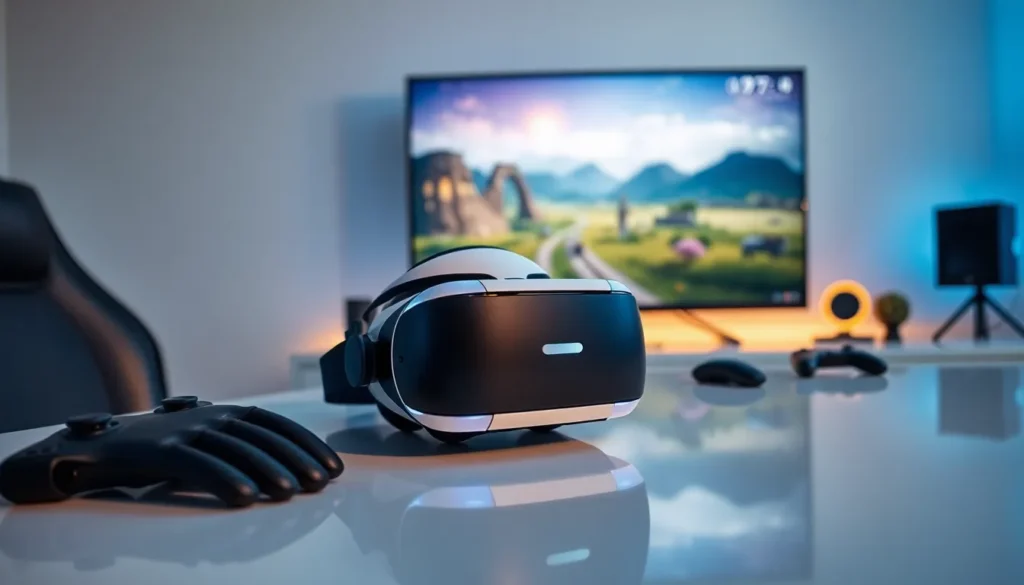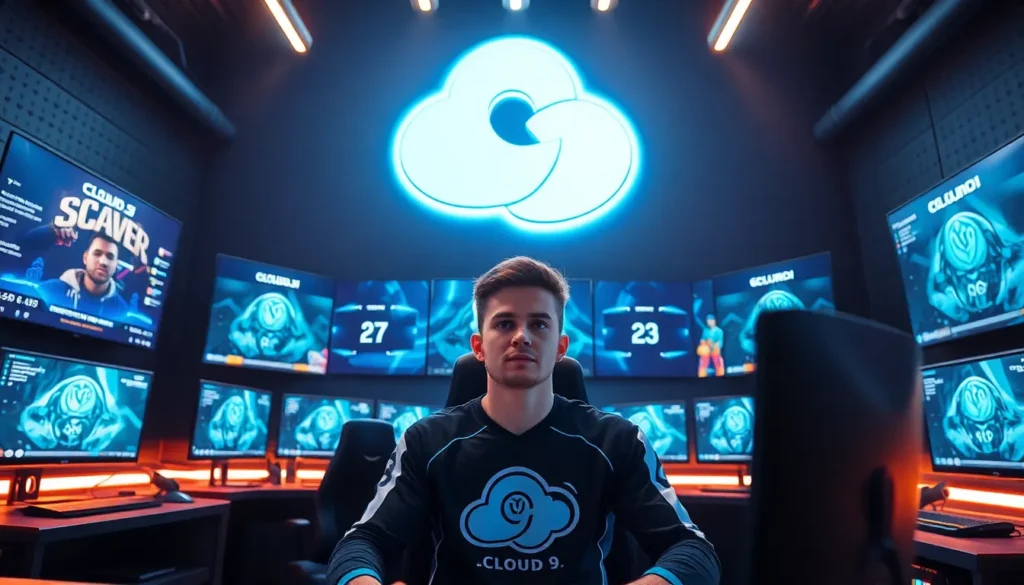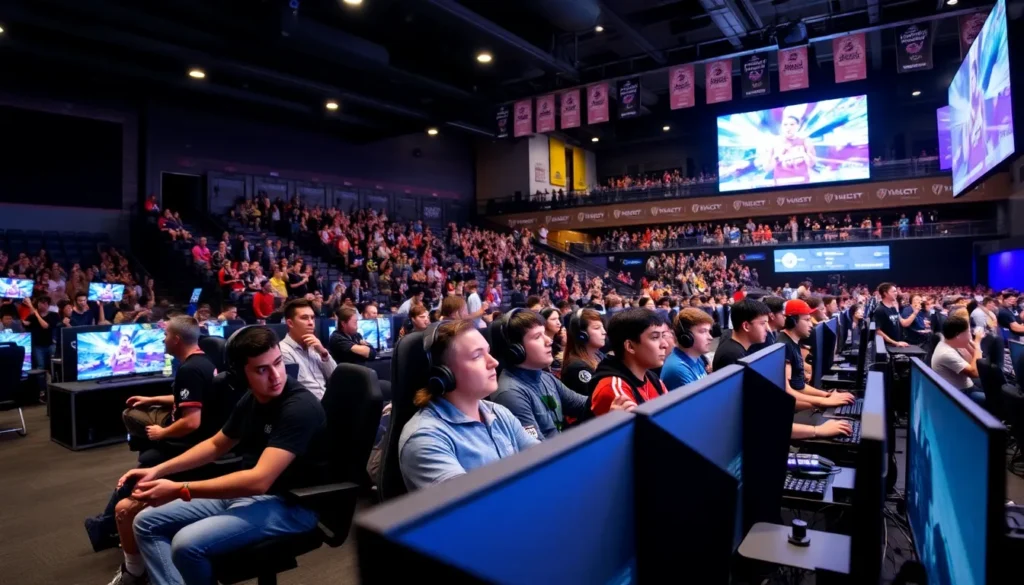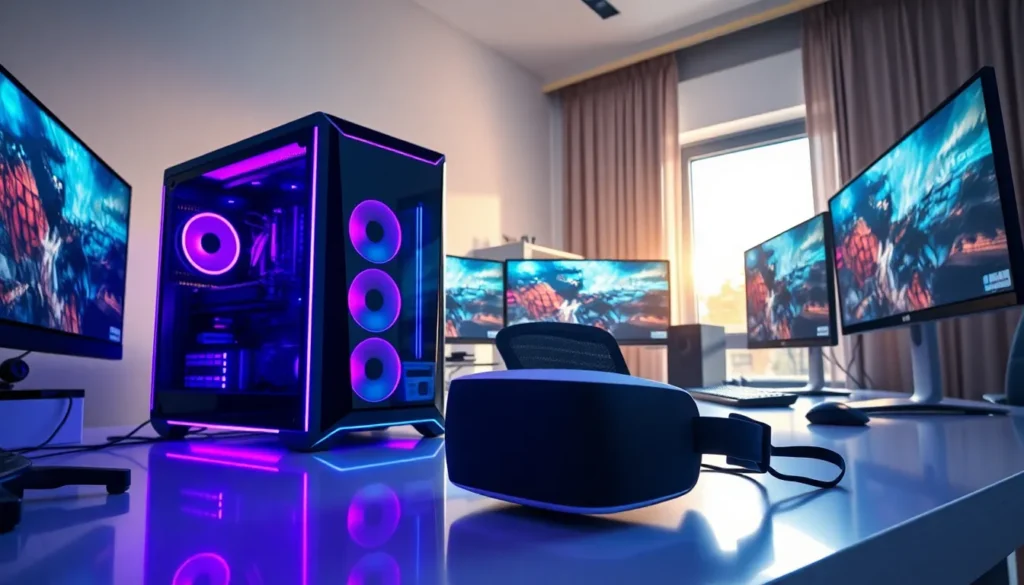Table of Contents
ToggleVirtual reality gaming has transformed the way players immerse themselves in digital worlds. With advancements in technology, creating the perfect VR gaming setup has become essential for an unforgettable experience. From headsets to controllers and the right space, every component plays a crucial role in bringing the virtual realm to life.
Setting up a VR gaming environment can be daunting, but it doesn’t have to be. Understanding the key elements needed for an optimal experience can make all the difference. Whether you’re a seasoned gamer or new to the VR scene, having the right equipment and a well-structured space can elevate gameplay and enhance enjoyment.
Overview of VR Gaming Setups
A VR gaming setup consists of several key components that work together to create an immersive experience. Understanding these elements helps optimize gameplay.
Headsets
Headsets serve as the primary interface between the player and the virtual world. Popular options include:
- Oculus Quest 2: Standalone device offering mobility and excellent graphics.
- Valve Index: Known for high fidelity visuals and precise tracking.
- HTC Vive Pro: Features a high-resolution display and robust tracking capabilities.
Controllers
Controllers enhance interaction within the VR environment. Essential types include:
- Tracked Controllers: Provide precise movement tracking, enhancing realism.
- Gesture Controllers: Enable natural hand movements, adding to immersive experiences.
- Gamepads: Compatible with many VR games, offering familiarity to players.
Sensors and Cameras
Sensors maintain tracking precision and ensure an accurate representation of user movements. Key components include:
- External Sensors: Placed around the play area, offering comprehensive tracking coverage.
- Built-in Cameras: Utilize inside-out tracking technology, reducing setup complexity.
Play Area
Establishing a suitable play area is crucial for safety and movement. Consider these aspects:
- Space Requirements: A minimum of 6.5 feet by 6.5 feet is recommended for active games.
- Obstacles: Clear the area of furniture and hazards to prevent accidents.
PC Specifications (for PC-based VR)
For those using PC-based VR systems, high-performance hardware is essential. Recommended specifications include:
| Component | Recommended Specs |
|---|---|
| Graphics Card | NVIDIA RTX 2060 or AMD RX 5700 |
| Processor | Intel i5 or AMD Ryzen 5 |
| RAM | 16 GB |
| USB Ports | At least 3 USB 3.0 ports |
Each component of the VR gaming setup contributes significantly to the overall experience, making careful selection and arrangement critical.
Components of a VR Gaming Setup
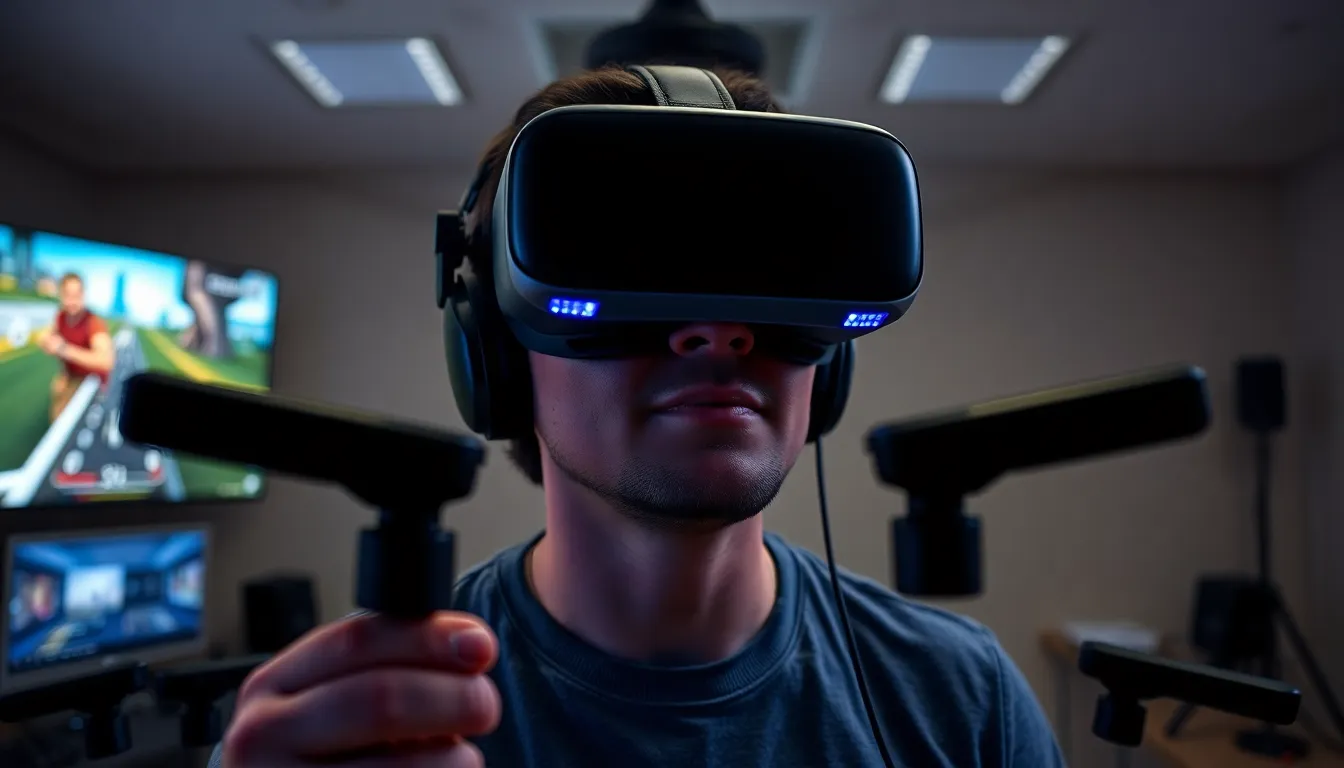
A comprehensive VR gaming setup includes essential components that enhance the immersive experience. Each part serves a specific function that contributes to overall gameplay quality.
Head-Mounted Display (HMD)
HMDs provide the primary visual interface in a VR setup. Options include the Oculus Quest 2, Valve Index, and HTC Vive Pro. Each headset features high-resolution displays, wide fields of view, and built-in audio systems. The Oculus Quest 2 excels in portability and standalone functionality. The Valve Index offers superior refresh rates and advanced tracking capabilities, while the HTC Vive Pro delivers exceptional image quality with dual OLED panels. Selecting an HMD that fits comfortably and meets individual preferences is crucial for an enjoyable experience.
Motion Controllers
Motion controllers facilitate user interaction within the virtual environment. Types include tracked controllers, gesture controllers, and traditional gamepads. Tracked controllers, like those from the HTC Vive and Oculus Rift series, utilize positional tracking for more accurate movement. Gesture controllers, such as Leap Motion, allow for natural hand movements without handheld devices. Gamepads provide a familiar control scheme for players transitioning from conventional gaming. Choosing controllers that align with gameplay style enhances immersion and responsiveness.
Tracking Sensors
Tracking sensors play a critical role in precision and accuracy within VR gaming. External sensors, such as the HTC Vive Base Stations, provide room-scale tracking, allowing for expansive movement in the play area. Inside-out tracking, used in Oculus Quest headsets, utilizes onboard cameras to map the environment, eliminating the need for external sensors. Adequate placement and calibration of these sensors ensure accurate tracking of user movements, reducing latency and improving the overall experience. A clear play area, free from obstacles, enhances tracking performance and safety.
Essential Hardware Requirements
Creating an effective VR gaming setup necessitates several essential hardware components, particularly for PC-based systems. Focusing on specific PC specifications and recommended graphics cards ensures an optimal gaming experience.
PC Specifications
VR gaming demands certain specifications to function smoothly. Key components include:
- Processor: A high-performance processor, such as Intel i5-4590 or AMD Ryzen 5 1500X, ensures the game runs efficiently and processes complex VR environments effectively.
- RAM: At least 8 GB of RAM is necessary for seamless performance. This amount supports multitasking and enhances overall gaming fluidity.
- USB Ports: A minimum of three USB 3.0 ports is essential for connecting headsets, controllers, and other peripherals. Ensure ports are easily accessible to facilitate quick setup adjustments.
Graphics Card Recommendations
The graphics card significantly affects VR gaming quality. Recommended models include:
- NVIDIA GeForce RTX 3060: Offers excellent performance with real-time ray tracing and fits a mid-range budget, providing a great compromise between price and capability.
- AMD Radeon RX 6700 XT: Competes closely with NVIDIA offerings, delivering strong performance in VR games and suitable for high-resolution displays.
- NVIDIA GeForce RTX 3080: A top-tier option for enthusiasts needing superior performance, this card handles demanding VR titles with maximum settings while ensuring smooth frame rates.
Selecting the right hardware not only enhances performance but also elevates the overall VR gaming experience, allowing players to fully immerse themselves in virtual worlds.
Setting Up Your VR Gaming Space
Creating an effective VR gaming space involves strategic planning of room dimensions and thoughtful organization to enhance the immersive experience.
Room Size and Layout Considerations
Selecting an appropriate room size significantly impacts the VR experience. Ideally, a play area should offer at least 6.5 feet by 6.5 feet of space to facilitate movement without obstruction. Clearance from walls or furniture enhances safety and freedom of motion. Layouts should minimize clutter and obstacles, incorporating cushioned flooring to reduce injury risk during gameplay. Consider using adjustable lighting options to enhance visual fidelity.
Cable Management Tips
Effective cable management improves aesthetics and prevents tripping hazards. Using cable ties or clips helps secure cables along walls and furniture, maintaining a neat appearance. Employing floor cable covers can shield wires in the play area, further reducing accidents. Opt for wireless peripherals where possible, as they eliminate cable-related clutter and simplify setup. Regularly checking connections and ensuring secure placement enhances reliability during gameplay.
Popular VR Gaming Platforms
Virtual reality gaming thrives on several popular platforms, each offering unique features and experiences tailored to various preferences.
Oculus Quest
Oculus Quest is a standalone VR headset, allowing users to enjoy a fully immersive experience without the need for a PC. It boasts a high-resolution display of 1832 x 1920 pixels per eye and a 72 Hz refresh rate, providing clear visuals. The Quest features inside-out tracking, making setup straightforward and eliminating the need for external sensors. Users can access a wide library of games and apps through the Oculus Store, with notable titles like “Beat Saber” and “Superhot VR.” Its portability and wireless capabilities make it a popular choice among casual gamers and enthusiasts alike.
HTC Vive
HTC Vive offers a PC-based VR experience, delivering high-quality graphics and immersive environments. The Vive features a display resolution of 1080 x 1200 pixels and a 90 Hz refresh rate, enhancing visual fidelity. It utilizes external base stations for tracking, allowing for room-scale VR experiences with precise motion detection. Users can customize their setups with various accessories, such as the Vive Controllers and Vive Tracker, which further expand gameplay possibilities. The SteamVR platform provides a vast selection of titles, including “The Walking Dead: Saints & Sinners” and “Half-Life: Alyx,” catering to gamers seeking detailed graphics and expansive worlds.
PlayStation VR
PlayStation VR provides a user-friendly VR gaming setup compatible with PlayStation 4 and PlayStation 5 consoles. With a resolution of 1920 x 1080 pixels and a 120 Hz refresh rate, it offers an enjoyable gaming experience. The headset connects easily to gaming consoles, making it accessible for owners of PlayStation systems. It supports a range of games available on the PlayStation Store, including “Astro Bot Rescue Mission” and “Blood & Truth,” appealing to both casual and serious gamers. PlayStation VR’s combination of affordability and quality makes it an attractive option for those entering the VR gaming space.
Creating an optimal VR gaming setup can transform the gaming experience into something truly immersive. By carefully selecting headsets controllers and tracking sensors players can enhance their interaction with virtual worlds. Choosing the right hardware and organizing the play area thoughtfully ensures smooth gameplay and safety.
As VR technology continues to evolve so do the possibilities for gamers. With the right setup players can dive deeper into their favorite games enjoying stunning graphics and lifelike interactions. Embracing these advancements not only elevates enjoyment but also opens the door to new gaming experiences that were once unimaginable.

